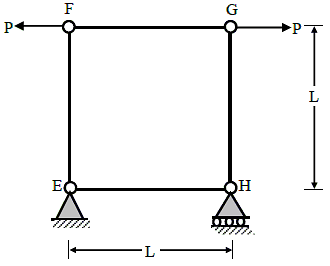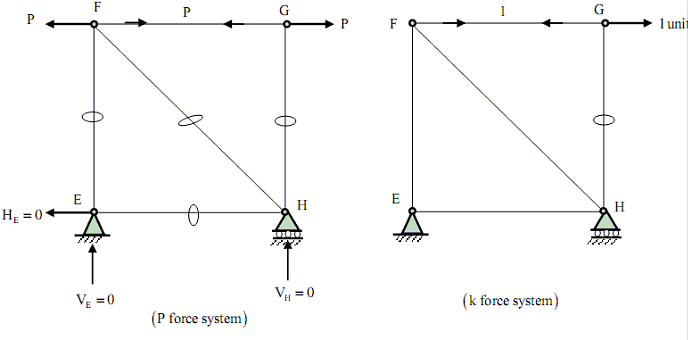Civil Engineering (CE) Exam > Civil Engineering (CE) Questions > A truss EFGH is shown in the figure, in whic...
Start Learning for Free
A truss EFGH is shown in the figure, in which all the members have the same axial rigidity R. In the figure, P is the magnitude of external horizontal forces acting at joints F and G.

If R = 500 × 103 kN, P = 150 kN and L = 3 m, the magnitude of the horizontal displacement of joint G (in mm, rounded off to one decimal place) is __________.
Correct answer is '0.9'. Can you explain this answer?
Most Upvoted Answer
A truss EFGH is shown in the figure, in which all the members have th...

Note: No need to calculate 'k' force in all members because 'P' force is zero fore all members, except FG.
By unit load method



|
Explore Courses for Civil Engineering (CE) exam
|

|
Similar Civil Engineering (CE) Doubts
A truss EFGH is shown in the figure, in which all the members have the same axial rigidity R. In the figure, P is the magnitude of external horizontal forces acting at joints F and G.If R = 500 × 103 kN, P = 150 kN and L = 3 m, the magnitude of the horizontal displacement of joint G (in mm, rounded off to one decimal place) is __________.Correct answer is '0.9'. Can you explain this answer?
Question Description
A truss EFGH is shown in the figure, in which all the members have the same axial rigidity R. In the figure, P is the magnitude of external horizontal forces acting at joints F and G.If R = 500 × 103 kN, P = 150 kN and L = 3 m, the magnitude of the horizontal displacement of joint G (in mm, rounded off to one decimal place) is __________.Correct answer is '0.9'. Can you explain this answer? for Civil Engineering (CE) 2025 is part of Civil Engineering (CE) preparation. The Question and answers have been prepared according to the Civil Engineering (CE) exam syllabus. Information about A truss EFGH is shown in the figure, in which all the members have the same axial rigidity R. In the figure, P is the magnitude of external horizontal forces acting at joints F and G.If R = 500 × 103 kN, P = 150 kN and L = 3 m, the magnitude of the horizontal displacement of joint G (in mm, rounded off to one decimal place) is __________.Correct answer is '0.9'. Can you explain this answer? covers all topics & solutions for Civil Engineering (CE) 2025 Exam. Find important definitions, questions, meanings, examples, exercises and tests below for A truss EFGH is shown in the figure, in which all the members have the same axial rigidity R. In the figure, P is the magnitude of external horizontal forces acting at joints F and G.If R = 500 × 103 kN, P = 150 kN and L = 3 m, the magnitude of the horizontal displacement of joint G (in mm, rounded off to one decimal place) is __________.Correct answer is '0.9'. Can you explain this answer?.
A truss EFGH is shown in the figure, in which all the members have the same axial rigidity R. In the figure, P is the magnitude of external horizontal forces acting at joints F and G.If R = 500 × 103 kN, P = 150 kN and L = 3 m, the magnitude of the horizontal displacement of joint G (in mm, rounded off to one decimal place) is __________.Correct answer is '0.9'. Can you explain this answer? for Civil Engineering (CE) 2025 is part of Civil Engineering (CE) preparation. The Question and answers have been prepared according to the Civil Engineering (CE) exam syllabus. Information about A truss EFGH is shown in the figure, in which all the members have the same axial rigidity R. In the figure, P is the magnitude of external horizontal forces acting at joints F and G.If R = 500 × 103 kN, P = 150 kN and L = 3 m, the magnitude of the horizontal displacement of joint G (in mm, rounded off to one decimal place) is __________.Correct answer is '0.9'. Can you explain this answer? covers all topics & solutions for Civil Engineering (CE) 2025 Exam. Find important definitions, questions, meanings, examples, exercises and tests below for A truss EFGH is shown in the figure, in which all the members have the same axial rigidity R. In the figure, P is the magnitude of external horizontal forces acting at joints F and G.If R = 500 × 103 kN, P = 150 kN and L = 3 m, the magnitude of the horizontal displacement of joint G (in mm, rounded off to one decimal place) is __________.Correct answer is '0.9'. Can you explain this answer?.
Solutions for A truss EFGH is shown in the figure, in which all the members have the same axial rigidity R. In the figure, P is the magnitude of external horizontal forces acting at joints F and G.If R = 500 × 103 kN, P = 150 kN and L = 3 m, the magnitude of the horizontal displacement of joint G (in mm, rounded off to one decimal place) is __________.Correct answer is '0.9'. Can you explain this answer? in English & in Hindi are available as part of our courses for Civil Engineering (CE).
Download more important topics, notes, lectures and mock test series for Civil Engineering (CE) Exam by signing up for free.
Here you can find the meaning of A truss EFGH is shown in the figure, in which all the members have the same axial rigidity R. In the figure, P is the magnitude of external horizontal forces acting at joints F and G.If R = 500 × 103 kN, P = 150 kN and L = 3 m, the magnitude of the horizontal displacement of joint G (in mm, rounded off to one decimal place) is __________.Correct answer is '0.9'. Can you explain this answer? defined & explained in the simplest way possible. Besides giving the explanation of
A truss EFGH is shown in the figure, in which all the members have the same axial rigidity R. In the figure, P is the magnitude of external horizontal forces acting at joints F and G.If R = 500 × 103 kN, P = 150 kN and L = 3 m, the magnitude of the horizontal displacement of joint G (in mm, rounded off to one decimal place) is __________.Correct answer is '0.9'. Can you explain this answer?, a detailed solution for A truss EFGH is shown in the figure, in which all the members have the same axial rigidity R. In the figure, P is the magnitude of external horizontal forces acting at joints F and G.If R = 500 × 103 kN, P = 150 kN and L = 3 m, the magnitude of the horizontal displacement of joint G (in mm, rounded off to one decimal place) is __________.Correct answer is '0.9'. Can you explain this answer? has been provided alongside types of A truss EFGH is shown in the figure, in which all the members have the same axial rigidity R. In the figure, P is the magnitude of external horizontal forces acting at joints F and G.If R = 500 × 103 kN, P = 150 kN and L = 3 m, the magnitude of the horizontal displacement of joint G (in mm, rounded off to one decimal place) is __________.Correct answer is '0.9'. Can you explain this answer? theory, EduRev gives you an
ample number of questions to practice A truss EFGH is shown in the figure, in which all the members have the same axial rigidity R. In the figure, P is the magnitude of external horizontal forces acting at joints F and G.If R = 500 × 103 kN, P = 150 kN and L = 3 m, the magnitude of the horizontal displacement of joint G (in mm, rounded off to one decimal place) is __________.Correct answer is '0.9'. Can you explain this answer? tests, examples and also practice Civil Engineering (CE) tests.

|
Explore Courses for Civil Engineering (CE) exam
|

|
Signup for Free!
Signup to see your scores go up within 7 days! Learn & Practice with 1000+ FREE Notes, Videos & Tests.


























